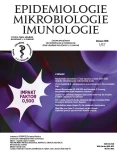Viral hepatitis A – seroprevalence and vaccine coverage rate in the South Moravian Region
Authors:
V. Ovesná; R. Ciupek *
Published in:
Epidemiol. Mikrobiol. Imunol. 67, 2018, č. 1, s. 12-17
Category:
Original Papers
*a kolektiv
Overview
Aim:
To map the current seroprevalence of antibodies and vaccine coverage against viral hepatitis A (VHA) in the general population of the South Moravian Region (SMR).
Material and methods:
During the VHA outbreak in 2016, nearly 3500 persons were investigated epidemiologically by the Regional Public Health Authority of the SMR within the anti-epidemic measures. The data collected were, among others, basic personal data and information whether the person has been vaccinated against VHA. For the reportedly vaccinated, the information was checked in the GP records or vaccination card. Those who reported to be unvaccinated were referred for serological testing. For the purposes of this retrospective prevalence study, available data on 3130 persons were analysed. The study population was divided into 10 age groups (0–4 years, 5–9 years, 10–14 years, 15–19 years, 20–24 years, 25–34 years, 35–44 years, 45–54 years, 55–65 years, and 65 years and over). The numbers of vaccinated persons with positive total antibodies and of those who tested negative were determined. The data obtained were statistically analysed using the Microsoft Excel tabular processor.
Results:
Of the study cohort of 3130 persons, 659 (21.05 %) turned out to be seropositive, and 320 (10.22 %) of the seropositives were vaccinated. The seroprevalence rates in the age groups over 35 years were increasing with increasing age, being the highest (51.40 %) in those aged 65 years and older. The highest vaccine coverage rates were achieved in the age groups 10–14 years (20.73 %) and 15–19 years (20.77 %).
Conclusion:
The seroprevalence rates of antibodies against VHA in the general population of the SMR are very low (21.05 %), being even lower than previously reported. The vaccine coverage rate against VHA is 10.22 %. The results show higher vaccine coverage rates in those born after the vaccine against VHA was implemented. Children show the highest vaccine coverage rates. Adults tend to get vaccinated less often. This fact promotes the risk of infection spread and outbreaks, as recently evidenced by the spread of infection from persons engaging in risky behaviours to the general population of young working-age adults.
Keywords:
viral hepatitis A – seroprevalence – vaccine coverage rate – susceptibility
Sources
1. Beran J, Douda P, Prymula R, et al. Hepatitis A vaccination by Havrix in the Czech U.N. Troops according to data of seroprevalence in 1991–1995. Central European Journal of Public Health 1996;4(2):87–90.
2. European Centre for Disease Prevention and Control. Hepatitis A virus in the EU/EEA, 1975–2014: A systematic review of seroprevalence and incidence comprising European surveillance data and national vaccination recommendations. Stockholm: ECDC; 2016.
3. Chlíbek R, Čečetková B, Smetana J, et al. Séroprevalence protilátek proti viru hepatitidy A, viru hepatitidy B u nevakcinované dospělé populace starší 40 let. Epidemiologie, mikrobiologie, imunologie 2006;55(3):99–104.
4. Chlíbek R, Smetana J, Čečetková B. Současnost očkování proti virovým hepatitidám. Postgraduální medicína, Příloha 2009;6:55–62.
5. Němeček V, Částková J, Fritz P, et al. The 2001 serological survey in the Czech Republic – viral hepatitis. Central European Journal of Public Health 2003;11(Suppl.):S54–61.
6. Němeček V. Sérologický přehled ČR v roce 2001 – Virová hepatitida A, B, C. Zprávy Centra epidemiologie a mikrobiologie 2003;12(Příloha 1):55–59.
7. Němeček V. Sérologický přehled virového zánětu jater typu A. Zprávy Centra epidemiologie a mikrobiologie 1998;7(Příloha 1):22–24.
8. Smetana J, Šošovičková R, Chlíbek R. Virová hepatitida A – stále aktuální onemocnění. Vakcinologie 2017;11(2):59–65.
9. World Health Organization. The global prevalence of hepatitis A virus infection and susceptibility: a systematic review. Geneva: World Health Organization; 2010.
10. World Health Organization. WHO position paper on hepatitis A vaccines – June 2012. Geneva: World Health Organization; 2012.
Labels
Allergology and clinical immunology Dermatology & STDs Paediatric dermatology & STDs Hygiene and epidemiology Medical virology Clinical microbiology LaboratoryArticle was published in
Epidemiology, Microbiology, Immunology

2018 Issue 1
Most read in this issue
- A new definition of sepsis (Sepsis-3) – aims, advantages, and controversies
- Nosocomial candidemia in the Czech Republic in 2012–2015: results of a microbiological multicentre study
- West Nile virus (lineage 2) in mosquitoes in southern Moravia – awaiting the first autochthonous human cases
- Viral hepatitis A – seroprevalence and vaccine coverage rate in the South Moravian Region
